Top News

May 17, 2019 Ryukyu Shimpo
By Ryota Shimabukuro
In April Professor Emeritus Akio Koizumi and Associate Professor Koji Harada, medical faculty members of Kyoto University, conducted a study concerning perfluorooctane sulfonate (PFOS), which is suspected to be carcinogenic. Specifically, they examined the concentration of PFOS in the blood of residents of Oyama, Ginowan City, Okinawa. On May 16 the Ryukyu Shimpo found that the study detected PFOS blood concentration levels of four times the national average.
High concentrations of PFOS were detected in rivers in the vicinity of U.S. Kadena Air Base and Futenma Air Station, and the bases have been pointed out as the sources of the contamination. The study also found that there had been negative effects on the subjects’ cholesterol levels and liver functions. Perfluorohexane sulfonic acid (PFHxS), the potential regulation of which is a topic ongoing international discussion, was also detected in the subjects’ blood at more than 53 times the national average.

The use of PFOS and perfluorooctanoic acid (PFOA) is generally prohibited within Japan. Since high concentrations of PFOS and PFOA were detected in the spring water used agriculturally in Oyama, Ginowan City, professors Koizumi and Harada received a request from Oyama residents and conducted examinations on April 13 and 14. They tested the concentrations of PFOS, PFOA, and PFHxS in the blood of 44 residents of Oyama, Ginowan City, and measured the same in the blood of 61 residents of Nanjo City to provide comparison.
Study results showed that in Ginowan City the concentration of PFOS in residents’ blood was four times the national average, at 13.9 nanograms per milliliter (ng/mL). In Ginowan City the results showed PFHxS concentrations at 16.3 ng/mL, more than 53 times the national average. Nanjo PFHxS levels were shown to be 3.9 ng/mL, 12.5 times the national average.
There is a possibility that the manufacture, import, export, and use of PFHxS will be banned by spring 2021. A connection has been drawn between a fire-extinguishing agent used by the U.S. military, and contamination by PFOS, PFOA, and PFHxS.
In Ginowan City, people who drink the tap water on a daily basis have higher concentrations of PFOS, PFOA, and PFHxS in their blood than people who do not drink the tap water. In comparison, in Nanjo City there was not a significant difference in concentration levels between people who drink tap water and those who do not.
The tap water in Ginowan City comes from the Chatan Water Treatment Plant (which supplies seven municipalities), which uses water from a river that passes through Kadena Air Base. Nanjo City’s tap water comes from the Nishihara Water Treatment Plant (which supplies nine municipalities).
Professors Koizumi and Harada pointed out, “It is unclear how [the chemicals] affect health, but judging from the difference from the rest of the country, the source of Ginowan City tap water (the Chatan Water Purification Plant) is contaminated.” They stated, “It is essential that the State shoulder the responsibility of formulating and upholding standards. The source of the contamination may be on base compounds, and it is important for this to be strictly controlled under domestic law.”
(English translation by T&CT and Erin Jones)
Go to Japanese
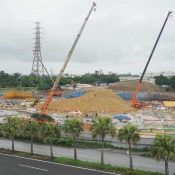
May 17, 2019 Ryukyu Shimpo
Okinawa City – Over six times the standard level of hexavalent chromium was detected at the construction site where Okinawa City is planning to build a 10,000 person-capacity multi-purpose arena on May 16. Hexavalent chromium is sometimes found in the ground at construction sites, as it exists in cement. However, in Okinawa it is mainly discovered coming from U.S. military bases, or as ground pollution in the remains of past U.S. bases, and some are concerned that this current case of pollution is coming from U.S. military waste.
The construction site for the arena in Yamauchi, Okinawa was used as a garbage incineration plant until 1970, when it was repurposed as a bullfighting ring run by Koza City in 1972. In 2018, the bullfighting ring was demolished to make way for the arena, and in the remains large amounts of waste material was found mixed into the soil.
On January 11 of this year, Okinawa city conducted a soil survey of the area. The survey detected 0.275 milligrams of hexavalent chromium per liter of soil, over five times the maximum normal value (0.05 milligrams). According to the survey report, the top soil areas that exceeded five times the normal value contained waste materials, indicating, “The cause [of the high values] came from waste materials such as buried cement debris and decomposing metal that contains chrome.” Okinawa City has given their stance, announcing, “It is possible that this is caused by old construction debris.”
The area around the construction site has until now contained public works such as roads and storm drains. The head of the prefectural sewage and public works departments explained, “[The origin of the contamination] is unclear, since there is no data showing the dumping of waste material.” A representative from Okinawa City said, “It is unclear where it is coming from,” and added that because there is the possibility of it leaking into underground water, where it is highly soluble, they explained, “We are preparing water tests.” Okinawa University emeritus professor Kunitoshi Sakurai noted that cleaning materials containing hexavalent chromium were used during the Vietnam War, saying, “It is hard to believe that this came from household waste. It is not impossible that the source of this was U.S. military waste.”
[Terminology] Hexavalent Chromium – A heavy metal that is highly soluble in water and a known carcinogen. During the Vietnam War, Camp Kinser (also known as the Makiminato Service Area) in Urasoe, used a cleaning agent that contained hexavalent chromium to wash things such as trailers, heavy machinery, and engines, which was discovered by Okinawa and Urasoe during a survey in 1976. It was also confirmed that the people who worked on the base had been complaining of health problems. Hexavalent chromium was also detected at the remains of Camp Kuwae in Chatan, in some places reaching 17 times the standard amount.
(English translation by T&CT and Sam Grieb)
Go to Japanese
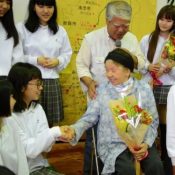
May 17, 2019 Ryukyu Shimpo
By Wakana Arakaki
Toshie Asato is the eldest professional Battle of Okinawa storyteller in Okinawa, upon whom the movie Gama: Getto no Hana was modeled. At the age of 98, she has decided to stop storytelling due to poor physical health. On May 16, she held her final storytelling event at Kishaba Community Center in Kitanakagusuku Village. To the students gathered, who were visiting Okinawa on a field trip, Asato said, “It has been my mission to tell stories as long as I live. So that there is never such a wretched battle [as the Battle of Okinawa] again, please, everyone convey [these stories] to future generations.” With these words she passed the baton to younger generations.
Asato began her storytelling career in 1981 at a lecture event, as part of a nationwide working women’s gathering in which she participated.
She told her personal experience of losing her husband, her two children, and 11 relatives in the Battle of Okinawa. She has spent about 40 years conveying the tragedies of war to her audiences.
Asato has received many requests from all over Japan inviting her to come and tell her stories. She has been everywhere from Hokkaido through Kyushu, and has managed as many as three storytelling events in a day. In recent years, in consideration of her physical health, her aides have added breaks into her schedule. Although the number of her events declined, she felt strongly about continuing to tell her stories.
More than 20 years after Okibe Junior High School in Osaka Prefecture started taking field trips to hear Asato’s stories, students from the school took a field trip on May 16 to listen to her.
Mitsuo Matsunaga, 65, a long-time aide to Asato, told the students about Asato’s personal experiences. Asato took the mic from time to time to repeat her strong warning to the students: “Let’s make sure a battle like this never, ever happens again.”
The students showered her with gratitude and said if they were ever offered to come see her again, they would jump at the chance.
One 14-year-old student who heard Asato’s stories said, “I want to convey the things I have studied so far and the stories I have heard today to my juniors.” Another student, also 14, stated, “I am thinking about what each of us can do for peace, and I would like to collaborate.”
(English translation by T&CT and Erin Jones)
Go to Japanese

May 17, 2019 Ryukyu Shimpo
For the first time ever, the Thai Festival hosted by the Embassy of Thailand in Japan is to take place as early as this fall in Okinawa. The festival is being advertised on the Embassy of Thailand’s homepage. The festival is known for being hosted around the world and takes pride in the ability to attract customers. Up until now, the festival has been hosted in Tokyo 20 times and attracted 20 to 30-thousand people in a span of two days, such as a weekend. An Okinawa Prefecture Tourism Promotion Division representative said, “In preparation for hosting (the festival) this fall, we’ve been making adjustments with Thailand since last year. We’re aiming to attract tens of thousands of people.”
On May 11 and 12, the Thai Festival took place at Tokyo’s Yoyogi Park and was bustling with people. The festival offered a variety of booths serving Thai food and miscellaneous goods. Since awamori is brewed using Thai rice, the Okinawa Prefecture Sake Brewers Association offered awamori at one of the booths. There were also performances by artists that are popular in Thailand, such as BNK48, which is a part of the AKB48 group.
An Okinawa Prefecture Sake Brewers Association representative has high hopes and said, “This is the second time we’ve had a booth at (a Thai Festival) held in Tokyo. This time around, about 3-thousand cups worth were sampled in two days, and we were able to get a lot of feedback via surveys. This year, there are plans to host a festival in Okinawa, so we hope to promote awamori there as well.”
During a press conference on May 14, Minister of State for Okinawa Mitsuhiro Miyakoshi said, “We aim to host the first Thai Festival in Okinawa this fall and preparations for it are underway. There are direct flights between Okinawa and Thailand and we hope that through hosting the festival, friendship between the two countries will grow, and that it will also contribute to increased consumption of Ryukyu awamori, which uses Thai rice.”
(English translation by T&CT and Chelsea Ashimine)
Go to Japanese
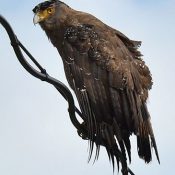
May 10, 2019 Ryukyu Shimpo
Ishigaki – The Okinawa Defense Bureau announced May 9 that during an environmental monitoring survey conducted at the end of April in Hirae, Ishigaki, where the JSDF plans to deploy, the found a crested serpent eagle, a national special natural monument, building a nest in the deployment area. Construction work was temporarily suspended, with the ODB stating, “We would like to resume construction taking into consideration the advice of Ishigaki city and experts, including the measures necessary to protect [the bird].”
According to the ODB and Ishigaki City, the survey, which took place from April 24-26, confirmed activity such as a pair of male birds staking their territory about 400 meters from the construction site, and suspended construction starting April 26. The same day, the ODB informed the city of the situation.
On May 7, recommendations from experts were heard and included advice such as due to the birds’ distance from the construction site, activity that does not create loud sudden machine noises would not be an impediment. The ODB is continuing to listen to experts, and a date to resume construction is still pending.
The city also asked the opinion of a local expert, who largely agreed about the effects of continuing construction. Ishigaki Mayor Yoshitaka Nakayama said in an interview May 9, “The suitable thing to do is to ensure that we do not effect breeding.” There has not yet been a request to halt construction altogether.
(English translation by T&CT and Sam Grieb)
Go to Japanese
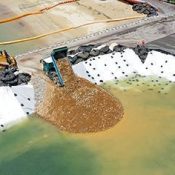
May 12, 2019 Ryukyu Shimpo
By Saki Yoshida
The Okinawa Defense Bureau (ODB) is advancing construction, such as building seawalls and depositing soil, to entrench the “outer moats” of the Futenma Replacement Facility (FRF). Photographs taken from drones have become a precious method by which to record and communicate the status of construction progress. The Ryukyu Shimpo has also gathered data while aboard boats at the site.
Limited Visibility
In April citizens boarded boats and protested against FRF construction near the shore portion of Henoko in Nago City, saying things like, “Heed popular will against the base,” and “Stop dropping crushed rock [into the ocean].” The sound of rock hitting rock resounded in the air as cranes dropped crushed rock into the ocean from on top of the K8 seawall located on the East side of Cape Henoko. Citizens kept on protesting, raising their fists into the air.

On March 28 this truck probably made soil deposits at the land reclamation area. It stopped at the seawall and could not be observed once inside the area.
Since the ODB began making soil deposits in March, dump trucks have been seen hauling soil to the land reclamation area and making ongoing soil deposits into the ocean. From the ocean, it is difficult to tell how much soil is being transported or the state of affairs within the seawalls.
Effects of the Reform Bill
The reform bill on current drone regulations in Japan is aimed at banning drone flying in the water and air space provided to the U.S. military.
As entering U.S. military bases is restricted, aerial photography has become a means of collecting data. If aerial photography of the FRF construction site were banned, it would be difficult for the OPG, as it insists upon, to be informed on red soil runoff and the progress of FRF construction. This is an attempt to veil the situation in Henoko, which has drawn a lot of attention from both Okinawan and Japanese citizens.
Observing the bases is permitted, so the reform bill will make monitoring more difficult. It will warrant the U.S. military to not display what it does not want to show, which risks reducing the freedom of the press. This could lead to citizens no longer being able to exercise their right to access information. These dangers sneaking up on the citizens are very real.
(English translation by T&CT and Erin Jones)
Go to Japanese

May 8, 2019 Ryukyu Shimpo
Nago City, Okinawa Prefecture published an anthology on the city’s history titled “The U.S. Military Operations and Civilian Internment Districts 1945-1946 – Centered in Yambaru, Nago.” It contains translations of records by U.S. military officers and photographs from the time. It also sheds light on the U.S. military administration’s aim and circumstances that led to the establishment of civilian internment camps. On April 25, members of the Nago City Municipal Board of Education Cultural Division City History Section held a press conference at the former Sakiyama Library to give a summary of the anthology.
The anthology is based on the “Papers of James T. Watkins,” a collection of U.S. military reports and journals, which were compiled by U.S. military officer James Thomas Watkins. Using the location names from the documents as clues, resources related to the northern area of the main island of Okinawa were sought out to be translated into Japanese, then included in the anthology.
The anthology makes it clear that the U.S. military was executing military operations based on elaborate statistics. In a report that is included in the anthology states that 60-thousand refugees were in the south-central area due to the Battle of Okinawa. City History Section member Akira Kawamitsu explained, “Unlike the Japanese military, the U.S. military had a grasp of everything and matter-of-factly carried out the Battle of Okinawa.”
Meanwhile, a different report states that civilians were relocated to a different area so the U.S. military could use the internment camps for a different purpose during the Battle of Okinawa. Kawamitsu stressed that, “The U.S. military was looking at the Okinawan citizens from the perspective of ‘What should we do with the residents that are in the way?’ We can see that the troops weren’t there to protect the residents.”
The content of the anthology is meant to complement the “History of Nago City 3 – Battle of Okinawa in Yambaru, Nago ” that was published in 2016. With the publication of the anthology, publication of “History of Nago City 3 – Battle of Okinawa Series -” has come to an end, but Kawamitsu said, “In preparation for next year, we hope to work on a collection of testimonies (by those who experienced the Battle of Okinawa).” The anthology can still be purchased at the Nago Museum and bookstores within Nago City. It can also be mailed if the purchase is made from outside the city. They are 1,700-yen each including tax. For more information, contact the Nago City Municipal Board of Education Cultural Division City History Section at 0980 (53) 5402.
(English translation by T&CT and Chelsea Ashimine)
Go to Japanese
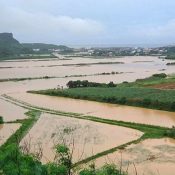
May 13, 2019 Ryukyu Shimpo
A record rainfall of a magnitude expected once every 50 years hit Yonaguni Island on May 13, which lost its intensity by afternoon, turning into a light shower. The Japan Meteorological Agency (JMA) is urging people to stay alert of mudslides triggered by the heavy rainfall.
According to the JMA, the rain clouds responsible for the deluge moved far off the eastern coast by afternoon. Severe rain and flooding alerts issued in the morning were lifted at 2:34 p.m., along with the sediment disaster advisory, an advisory prompted by elevated risks of a mudslide. However, the JMA is asking people to remain cautious of heavy rain and mudslides, as there are several areas where the precipitation likely loosened the soil.
Yonaguni’s local government said it set up a disaster management center at 7:30 a.m., and issued an island-wide evacuation advisory at 9 a.m. The town confirmed at least ten streets were inundated as of 2:30 p.m., as well as four residential areas flooded below floor level, and three residential areas flooded above floor level. No injuries were reported at the time.
According to the local school boards and schools, Hikawa Kindergarten and Hikawa Elementary School were both closed for a day due to the torrential rain, while Kubura Middle School dismissed students in the afternoon.
The Okinawa Meteorological Observatory reported that the observation point at Yonaguni Airport recorded 109.5 millimeters (4.31 inches) of rainfall over a one-hour period at 7:26 a.m., the highest ever for the month of May. Another observation point in Sonai, Yonaguni Island, recorded 98.5 millimeters (3.87 inches) of rainfall over a one-hour period at 9:51 a.m. Over a 24-hour period, each observation point recorded 458.5 millimeters (18.05 inches) and 457.0 millimeters (17.99 inches) of rainfall at 2:20 p.m., respectively—the highest ever numbers recorded for the month of May.
(English translation by T&CT and Monica Shingaki)
Go to Japanese
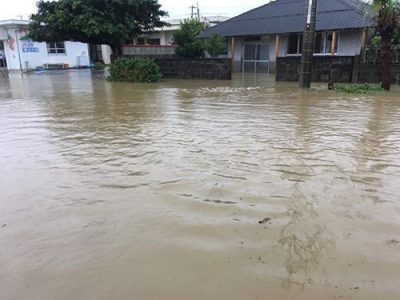
The street in front of Hostel Omoro in Sonai is completely underwater by 10 a.m. (Courtesy of Yonaguni Town Hall)
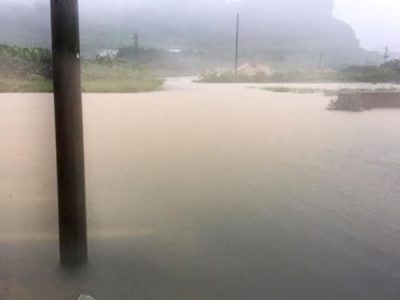
By 10 a.m. the area facing this Multicomplex facility is totally submerged. (Courtesy of Yonaguni Town Hall)
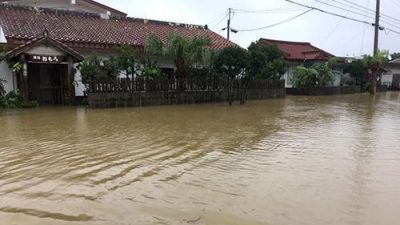
Hostel Omoro and its street from another angle, also around 10 a.m.(Courtesy of Yonaguni Town Hall)
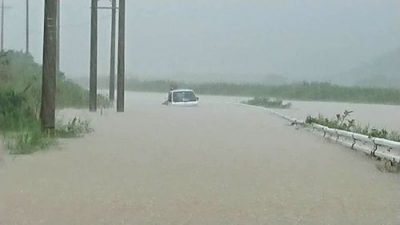
A flooded road along Tabaru river in Sonai, at 10 a.m. on Monday. (Courtesy of Yonaguni Town Hall)
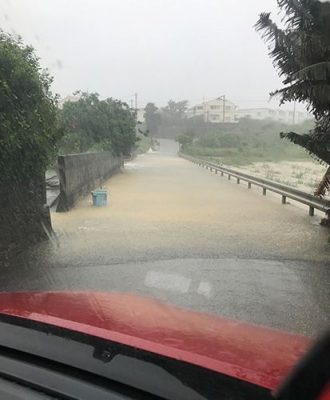
Another immersed road at a village in Sonai, around 10 a.m. (Courtesy of Yonaguni Town Hall)
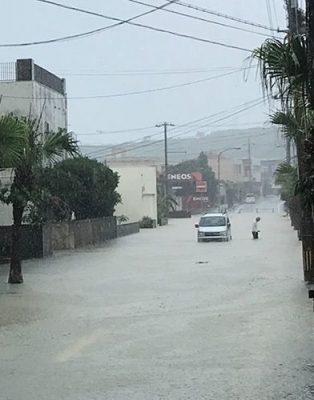
Highway 216 is also underwater by 10 a.m. in Sonai. (Courtesy of Yonaguni Town Hall)
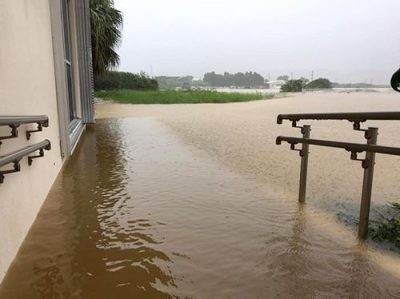
The inundated front area of a multicomplex facility in Sonai on the same day, around 10 a.m.(Courtesy of Yonaguni Town Hall)
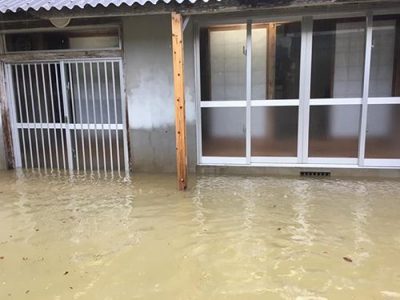
A flooded home in Sonai, around 10 a.m. (Courtesy of Yonaguni Town Hall)
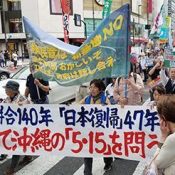
May 13, 2019 Ryukyu Shimpo
(Tokyo) On May 12, the Okinawa One-Tsubo Anti-War Landholders Association, Kanto Bloc held a protest near Shinjuku Station in Tokyo to re-think “May 15,” as this year marks 140 years since the 1879 Ryukyu annexation (the “Ryukyu Disposition”) and 47 years since Okinawa’s reversion to Japan in 1972. According to organizer estimates, 260 people gathered for a rally, and they marched around the station, chanting, “pushing bases on Okinawa is discrimination!” and calling on passersby along the street to think about a resolution to Okinawa’s base issues.
At the rally, which was held in front of the Alta building outside Shinjuku Station’s East Exit, greetings were given by Okinawa Peace Movement Center director Hiroji Yamashiro and by Kiyosane Komesu, age 30, who sent an appeal to the city council of Koganei, a city in western Tokyo, calling for the state of U.S. bases in Japan to be contemplated by Japan as a whole. Yamashiro explained that the Okinawa prefectural government has estimated that the new base construction in Henoko, Nago will cost 2.5 trillion yen. Yamashiro questioned, “What kind of country would spend vast sums of money to build a base for another country’s military” while raising the consumption tax on its citizens? He criticized the government for proceeding with the construction.
Komesu said, “As someone who bears responsibility for the next generation of Uchina, I want to put an end to the history of discrimination and colonial rule that has continued unabated since the Ryukyu annexation.”
(English translation by T&CT and Sandi Aritza)
Go to Japanese
May 8, 2019 Ryukyu Shimpo
In a video message released by Prime Minister Abe Shinzo May 3, he announced his intention to revise Article 9 of the Japanese Constitution, including an explicit reference to the Japanese Self Defense Forces (JSDF), and stated that he was sticking to the goal of carrying out the revision by 2020. However, the calls from Japan’s citizens demanding this revision happen are not getting any louder. For the Abe administration and Diet ruling Liberal Democratic Party (LDP), the amendment itself has become the goal, and their aggressive methods and language are the only things that stand out.
In March of 2018, the LDP identified four constitutional amendments: (1) specifications in Article 9 for the JSDF, (2) the establishment of a state of emergency clause, (3) the elimination of “combined districts” in Upper House elections, and (4), doing away with educational fees and strengthening the education system.
Of the proposed revisions, the elimination of combined electoral districts, where a single electoral district straddles two prefectures, is an improvement, however it cannot be denied that a conversation about the electoral system as a constitutional theme feels a bit sudden. The elimination of these combined districts was approved by a single vote. Not enough discussion has been had about an issue that has major ramifications for the political power of voters.
The fortification of the education system is not a revision of the constitution itself, but rather looks at the laws that govern education such as the Basic Act on Education, and as such is suitable.
Making a specific reference to the JSDF in Article 9, as well as a “State of Emergency Clause” that would restrict the rights of citizens during emergencies, are the two true aims of their constitutional efforts. The hasty heaping on of the pleasant-sounding elimination of education fees is no more than a Hail Mary by Abe to get past the constitutional amendment hurdle.
When the LDP’s acting secretary general, Koichi Hagiuda, appeared on an internet TV program in April, he said regarding the activity of the Upper and Lower House, which has yet to meet even one time during the current parliamentary session, “When the new era (Reiwa) arrives, we need to move forward with a bit of a wild investigation of the constitution.” After receiving criticism from the opposing parties Hagiuda walked back the comments and issued an apology, however the true nature of the desperate LDP’s desire to revise the constitution had been revealed.
Until then, the drafted proposals for a constitutional amendment included common-good stipulations such as the establishment of a “Self-Defense Army” and a clause stating “a duty to defend our own country and society.” The Prime minister and LDP’s primary view of the constitution is that it should not control the power of the government, but has changed toward a trend of restricting the power of its citizens.
According to a public opinion survey conducted by Kyodo News in February and March, opposition to a revision of the Japanese constitution under an Abe administration was 54%, while those supporting it was just over 42%. Without commenting on the height of people’s understanding of the issue, the poll shows that Japan’s citizens see through the suspicious change in the goals of amending the constitution.
In June of 2014 in Saitama City, Saitama, a haiku about a demonstration to protect Article 9 was denied a posting at the community hall for the reason that it, “Harmed equality and neutrality.” In the lawsuit that followed, it was decided that the Saitama City had to pay damages to the author.
Public officials have a duty to respect the constitution, so to label something that expresses a desire to protect the constitution as “political” and use that as the grounds for removal is certainly odd. The Abe administration’s stance on constitutional revision has given birth to a wave of constitutional disrespect. It is fair to say that the “harm” was brought about by the government.
Prime Minister Abe should immediately abandon this constitutional amendment, one which does not have the understanding of the country’s citizens.
(English translation by T&CT and Sam Grieb)
Go to Japanese
May 8, 2019 Ryukyu Shimpo
On May 7 it became clear that the Ministry of Defense (MOD) is considering using both domestic work ships and work ships from abroad to conduct ground improvement work on the soft ground at the site in Henoko, Nago City, as part of construction of the Futenma Replacement Facility (FRF). As people criticize the lengthening period of FRF construction and, consequently, Futenma Air Station remaining fixed in place, the MOD is searching for methods to shorten the construction period.
Minister of Defense Takeshi Iwaya had an interview the same day, where he said he plans to soon submit the necessary application to the Okinawa Prefectural Government (OPG) for approval of alterations to the FRF construction plan, intended to shorten the construction period. He said, “We are playing our part to quickly finish construction in a logical fashion, and to quickly return Futenma.”
In a report concerning ground improvement work that the MOD submitted to the National Diet, the construction period for ground reinforcement work from on the ocean is estimated to take 3 years and 8 months, and the portion to be conducted on land is expected to take 1 year and 1 month. The plan for performing the ground reinforcement method, called the sand compaction pile method, will require bringing in 11 large domestic work ships. However, according to the MOD there are a total of 15 work ships in-service domestically, so it is looking to procure work ships from abroad.
Minister Iwaya said in an interview on May 7, “We will carry out the plan as quickly as possible, and speak earnestly with Okinawa as we steadily advance construction as quickly as possible.” At a joint hearing by opposition parties in the National Diet on the same day, an MOD representative explained, “We want to thoroughly and closely investigate [procuring work ships from abroad].”
The MOD report indicates that it can adjust the planned process, which specifies not concentrating work ships in the area simultaneously, while keeping the effects to the environment such as noise, air quality, and marine life within the initial plan’s expected scope. Contrary to that claim, if the MOD shortens construction time by increasing the number of work ships, it will unavoidably cause a greater burden on the environment.
(English translation by T&CT and Erin Jones)
Go to Japanese



















 Webcam(Kokusai Street)
Webcam(Kokusai Street)


